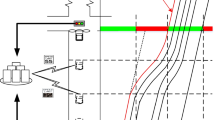Abstract
In the near future, autonomous vehicles will be able to share information with other vehicles via communication, enabling appropriate traffic control approaches. A new approach to traffic control using fully autonomous driving involves the realization of a flat interchange. Unlike conventional approaches, this study focused on roads and interchanges that do not assume lanes. Specifically, we propose an interchange flow control approach to traffic control using a virtual wall (VW), which acquires and shares the initial position, destination, and speed of all vehicles entering an interchange in a two-dimensional space where vehicles can move freely, and then realizes appropriate control based on this information. Each vehicle individually calculates the shortest path to avoid the VW, thereby realizing a safe and rational path selection. In this study, a genetic algorithm was used to determine the location of the VW. The effectiveness of the proposed method was evaluated using simulations, and the results showed that compared to manual deployment in the roundabout form, the proposed method using VWs reduced the total path length and the number of collisions to zero. In addition, when comparing the case where VWs were deployed in common for all vehicles and the case where VWs were deployed individually for each vehicle, it was shown that the total path length was shorter when individual VWs were deployed.


















Similar content being viewed by others
Data availability
We are not currently considering publishing the data used in our paper.
References
Perez J (2019) A Review of Sensor Technologies for Perception in Automated Driving. IEEE Intell Transp Syst Mag 11(4):94–108. https://doi.org/10.1109/MITS.2019.2907630
ITS Connect Promotion Consortium, “https://www.itsconnect-pc.org/en/” [Accessed April 27, 2023]
Vehicle to X (V2X) platform, “https://www.hitachi- solutions.com/v2x/?_ga=2.64036906.486721716.16749608 10–1945221485.1674960810&_gl=1*1dhyz6m*_ga*MTk0NT IyMTQ4NS4xNjc0OTYwODEw*_ga_6Q6Z8YG8NG*MT Y3NDk2MDgwOS4xLjAuMTY3NDk2MDgwOS42MC4wLjA” [Accessed April 27, 2023]
Y Wu, L Wu, H Cai (2023) A deep learning approach to secure vehicle to roadside unit communications in intelligent transportation system, Computers and Electrical Engineering, Vol. 105 108542, ISSN 0045–7906, https://doi.org/10.1016/j.compeleceng.2022.108542
Zeadally S, Guerrero J, Contreras J (2020) A tutorial survey on vehicle-to-vehicle communications. Telecommun System 73:469–489. https://doi.org/10.1007/s11235-019-00639-8
D Berg, V Mark, M Kreveld, O Marc, S Mark (2000) Visibility Graphs”, Otfried, Chapter 15, Computational Geometry (2nd ed.), Springer-Verlag, pp. 307–31
Lozano-Pérez T, Wesley A (1979) Michael “An algorithm for planning collision-free paths among polyhedral obstacles.” Commun ACM 22(10):560–570. https://doi.org/10.1145/359156.359164,S2CID17397594
Dijkstra EW (1959) A note on two problems in connection with graphs. Numriches Mathematic 1:269–271. https://doi.org/10.1007/BF01386390
I Ogawa, S Yokoyama, T Yamashita, H Kawamura, A Sakatoku, T Yanagaihara, H Tanaka (2017) Proposal of cooperative learning to realize motion control of rc cars group by deep q-network, Proceedings of the Annual Conference of JSAI, 3I2OS13b5–3I2OS13b5, https://doi.org/10.11517/pjsai.JSAI2017.0 3I2OS13b5
I Ogawa, S Yokoyama, T Yanashita, H Kawamura, A Sakatoku, T Yanagihara, T Ogishi, H Tanaka (2018) Efficiency of traffic flow with mutual concessions of autonomous cars using deep q-network, Proceedings of the Annual Conference of JSAI JSAI2018, 3Z204–3Z204, https://doi.org/10.11517/pjsai.JSAI2018.0 3Z204
A Pal, J Philion, YH Liao, S Fidler (2021) Emergent road rules in multi-agent driving environments”, International Conference on Learning Representations, 2021, URL https://openreview.net/forum?id=d8Q1mt2Ghw
J Schulman, F Wolski, P Dhariwal, A Radford, O Klimov (2017) Proximal Policy Optimization Algorithms arXiv:1707.06347
Shimada H, Yamaguchi A, Takada H, Sato K (2015) Implementation and Evaluation of Local Dynamic Map in Safety Driving Systems. J Transport Technol 05(2):102–112
Kishi Y, Cao W, Mukai M (2022) Study on the Formulation of Vehicle Merging Problems for Model Predictive Control. Artific Life Robot. https://doi.org/10.1007/s10015-022-00751-0
T Harada, K Hattori, J Matsuoka (2022) Behavior Analysis of Emergent Rule Discovery for Cooperative Automated Driving Using Deep Reinforcement Learning, Artific Life Robot
Bakibillah ASM, Kamal MAS, Tan CP, Susilawati S, Hayakawa T, Imura J (2021) Bi-Level Coordinated Merging of Connected and Automated Vehicles at Roundabouts. Sensors. https://doi.org/10.3390/s21196533
Kamal MAS, Tan CP, Hayakawa T, Azuma S-I, Imura J-I (2021) Control of Vehicular Traffic at an Intersection Using a Cyber-Physical Multiagent Framework. IEEE Transact Indust Informat. https://doi.org/10.1109/TII.2021.3051961
Kamal MAS, Hashikura K, Hayakawa T, Yamada K, Imura J-I (2022) Look-Ahead Driving Schemes for Efficient Control of Automated Vehicles on Urban Roads”. IEEE Transact Vehic Technol. https://doi.org/10.1109/TVT.2021.3132936
Snape J, Berg JVD, Guy SJ, Manocha D (2011) The Hybrid Reciprocal Velocity Obstacle”. IEEE Transact Robot. https://doi.org/10.1109/tro.2011.2120810
Sayin O, Muhammed L, Chung-Wei S, Shinichi S, Jiajun B, Tamer S (2019) Information-Driven Autonomous Intersection Control via Incentive Compatible Mechanisms. IEEE Transact Intell Transport Syst 20:3
R Tachet, P Santi, S Sobolevsky, L Ignacio Reyes-Castro, E Frazzoli, D Helbing, C Ratti (2016) Revisiting Street Intersections Using Slot-Based Systems, PloS one journals.plos.org
Holland JH (1992) Genetic Algorithms. Sci Am 267(1):66–73
geneticalgorithm2, “https://github.com/PasaOpasen/geneticalgorithm2/blob/ma ster/README.rst”, [Accessed January 27, 2023]
The Hybrid Reciprocal Velocity Obstacle, “https://github.com/atb033/multi_agent_path_planning?tab=readme-ov-file#decentralized-solutions”, [Accessed December 10, 2023]
Harada T, Alba E (2020) Parallel Genetic Algorithms: A Useful Survey. ACM Comput Surv. https://doi.org/10.1145/3400031
Author information
Authors and Affiliations
Corresponding author
Additional information
Publisher's Note
Springer Nature remains neutral with regard to jurisdictional claims in published maps and institutional affiliations.
This work was submitted and accepted for the Journal Track of the joint symposium of the 29th International Symposium on Artificial Life and Robotics, the 9th International Symposium on BioComplexity, and the 7th International Symposium on Swarm Behavior and Bio-Inspired Robotics (Beppu, Oita and Online, January 24-26, 2024).
About this article
Cite this article
Hoshino, J., Itoh, Y., Saotome, R. et al. Interchange flow control with dynamic obstacles optimized using genetic algorithms—a concept of virtual walls. Artif Life Robotics 29, 230–241 (2024). https://doi.org/10.1007/s10015-024-00946-7
Received:
Accepted:
Published:
Issue Date:
DOI: https://doi.org/10.1007/s10015-024-00946-7




